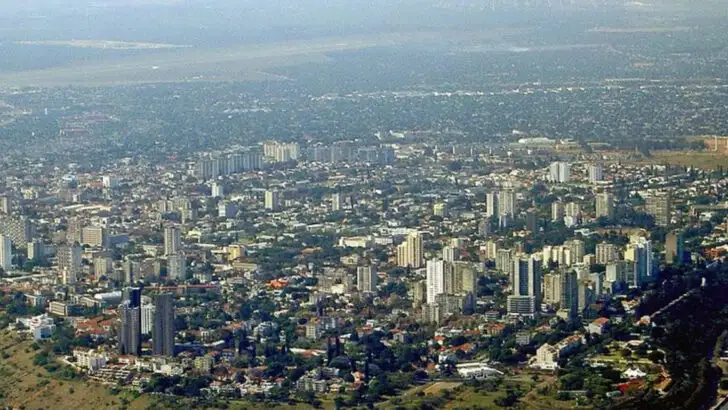Africa is a continent of stories, traditions, and living history, and some of its cities shine brightest where travelers least expect. Beyond the famous capitals and tourist hubs, there are places where centuries-old customs, vibrant festivals, and remarkable architecture still shape daily life.
These underrated African cities invite visitors to experience culture in its purest form — from colorful markets and historic mosques to music, art, and food scenes that carry forward the soul of their communities. They’re destinations that prove heritage isn’t just preserved; it’s alive and celebrated.
Asmara, Eritrea
Asmara is a blend of Italian architecture and African vibrancy. The city’s streets are lined with Art Deco buildings that whisper tales from another era. Known as “Little Rome,” it offers a nostalgic walk through history.
Its colorful markets and lively cafes bring the culture to life. Asmara’s charm lies in its unique juxtaposition of modernity and tradition, offering visitors an unparalleled glimpse into Eritrean life.
Whether it’s a stroll through its boulevards or sipping coffee at local spots, Asmara enriches the soul with its unpretentious beauty.
Lamu, Kenya
Lamu feels like stepping into a historical novel, with its narrow alleyways and ancient Swahili architecture. This UNESCO World Heritage site is a living museum with no cars, only donkeys and dhows.
Its pristine beaches and vibrant culture make it a serene escape from modern chaos. The Lamu Cultural Festival, celebrated annually, showcases the island’s rich traditions.
Experience the hospitality of its people and the tranquility of its lanes, making Lamu a perfect blend of heritage and natural beauty.
Saint-Louis, Senegal
Saint-Louis captivates with its colonial architecture and rich musical heritage. Once the capital of French West Africa, its streets echo stories of a bygone era.
The city, perched on an island at the mouth of the Senegal River, is known for its jazz festivals and vibrant cultural scene. Its unique ambiance draws artists and musicians alike.
A stroll through Saint-Louis offers a sensory journey through history, music, and art, making it a cultural treasure.
Gondar, Ethiopia
Known as the “Camelot of Africa,” Gondar is home to spectacular castles and fortresses. This historical city was once the center of Ethiopian power, reflecting a rich royal legacy.
The annual Timkat festival adds a lively burst of color and tradition, attracting visitors from far and wide. Here, history is not just seen but felt.
The echoes of past emperors and the vibrant Ethiopian culture make Gondar a must-visit for history enthusiasts.
Ouidah, Benin
Ouidah, steeped in history and spirituality, is often associated with the transatlantic slave trade. The Door of No Return serves as a poignant reminder of its past.
Beyond its historical significance, the city is the spiritual heart of Voodoo, offering unique rituals and ceremonies.
Visitors can experience a deep connection to African culture here, making Ouidah a haunting yet captivating destination.
Zanzibar City, Tanzania
Zanzibar City is the beating heart of the Spice Islands. Its Stone Town is a labyrinth of narrow alleys, bustling markets, and grand Arab mansions.
The scent of spices fills the air, while the sound of Taarab music adds to the allure. This UNESCO World Heritage site offers a sensory overload of history and culture.
From its vibrant markets to its beautiful beaches, Zanzibar City is a cultural tapestry waiting to be unraveled.
Kumasi, Ghana
As the cultural soul of Ghana, Kumasi is vibrant and full of life. The city’s bustling markets overflow with kente cloth, beads, and crafts reflective of the Ashanti culture.
Home to the Ashanti king and the opulent Manhyia Palace, it offers a deep dive into Ghanaian traditions. Festivals like Akwasidae showcase its rich heritage.
Kumasi’s lively atmosphere and cultural depth make it a fascinating stop for anyone seeking authentic African culture.
Harar, Ethiopia
Harar’s winding streets and colorful houses create a unique tapestry of culture and tradition. Known for its ancient walls and over 100 mosques, it holds a special place in Islamic history.
Its vibrant markets and the tradition of feeding hyenas add to its mystique. Recognized as a UNESCO World Heritage site, Harar boasts a rich cultural mosaic.
Visitors are drawn to its blend of spirituality and history, making it an intriguing destination.
Maputo, Mozambique
Maputo blends colonial elegance with modern dynamism. The city is known for its vibrant arts scene, buzzing restaurants, and lively music.
Colorful murals and historic architecture tell stories of resilience and creativity. The Maputo Central Market is a cultural hub where flavors and crafts converge.
With its rich cultural offerings and welcoming vibe, Maputo invites exploration and appreciation.
Bobo-Dioulasso, Burkina Faso
Bobo-Dioulasso, often dubbed “Bobo,” is a melting pot of cultures and traditions. Known for its Sudano-Sahelian architecture, it presents a visual feast for visitors.
The city’s vibrant music scene and traditional dances add rhythm to its daily life. Markets brimming with crafts and textiles reflect its rich cultural tapestry.
Bobo’s infectious energy and artistic spirit make it a gem in Burkina Faso’s cultural landscape.
Fes, Morocco
Fes, a city of enchanting alleys and ancient traditions, offers an immersive cultural experience. Its medina, a UNESCO World Heritage site, is a maze of history.
Here, the scent of spices, the sound of craftsmen, and the sight of intricate architecture captivate the senses. The University of Al Quaraouiyine stands as a beacon of knowledge and history.
Fes is a city where every corner tells a story, making it a must-visit for culture lovers.
Stone Town, Zanzibar
In Stone Town, history and culture weave a rich tapestry. This UNESCO World Heritage site is a mosaic of Swahili, Arab, Persian, and European influences.
Its narrow streets are alive with the aroma of spices and the sound of music echoing through the air. The iconic Zanzibar doors and vibrant markets add charm.
Stone Town’s cultural depth provides a unique glimpse into a world where past and present collide beautifully.
Lalibela, Ethiopia
Lalibela is a spiritual heart of Ethiopia, known for its monolithic churches carved out of rock. These architectural wonders attract pilgrims from around the world.
The city’s religious ceremonies offer a mesmerizing glimpse into Ethiopian Orthodox traditions. Each structure tells stories of devotion and artistry.
Lalibela stands as a testament to human faith and ingenuity, making it a must-see for those seeking spiritual and historical depth.
Mombasa, Kenya
Mombasa is a city where history meets the sea. Known for its Swahili culture and stunning beaches, it’s a hub of historic sites like Fort Jesus.
The city’s vibrant markets offer a taste of local life, filled with spices and crafts. Its coastal charm and cultural richness invite visitors to explore.
Mombasa’s blend of history and natural beauty makes it a captivating destination for travelers.
Djenné, Mali
Djenné is a city that stands as a testament to Mali’s rich history. The Great Mosque, a UNESCO World Heritage site, is an architectural marvel.
Every Monday, the lively market fills the city with color and energy, offering insights into local life. Djenné’s mud-brick architecture adds to its unique allure.
A visit here is a journey through time, showcasing the ingenuity and spirit of its people.
Mahébourg, Mauritius
Mahébourg offers a window into Mauritius’s rich history and culture. This charming town, with its waterfront and historical buildings, is a reflection of the island’s past.
The local market is a vibrant hub where culture and tradition meet. Its leisurely pace and friendly locals make Mahébourg a delightful escape.
The town’s mix of history and serene beauty offers a refreshing cultural experience.
Kano, Nigeria
Kano, one of Nigeria’s oldest cities, is a place where history resonates through its ancient walls and bustling markets.
The city’s traditional Hausa architecture offers a glimpse into its rich cultural tapestry. Markets are filled with vibrant textiles and crafts.
Kano’s blend of history and cultural vitality makes it a fascinating destination for those intrigued by Nigeria’s past.
Tétouan, Morocco
Tétouan, known as the “White Dove,” is a city of stunning contrasts, where Andalusian architecture meets vibrant Moroccan culture.
The medina, a UNESCO World Heritage site, is a captivating maze filled with history and art. Its cultural influence is felt in every corner.
Tétouan’s unique blend of influences makes it a must-visit for those seeking a diverse cultural experience.
Antananarivo, Madagascar
Antananarivo, the capital of Madagascar, is a city of hills and vibrant culture. Its streets are alive with the sound of local markets and the sight of traditional Malagasy architecture.
The city offers a rich tapestry of history and modernity, where each neighborhood tells a different story.
Antananarivo’s blend of cultures and landscapes makes it a fascinating urban tapestry to explore.
Luanda, Angola
Luanda is a city where the past and present meet against a backdrop of coastal beauty. Its skyline is a mix of modern structures and colonial architecture.
The city’s cultural festivals and vibrant music scene offer a taste of Angolan life. Markets and waterfront promenades add to its appeal.
Luanda’s diverse character and energetic vibe make it a captivating stop for cultural enthusiasts.

